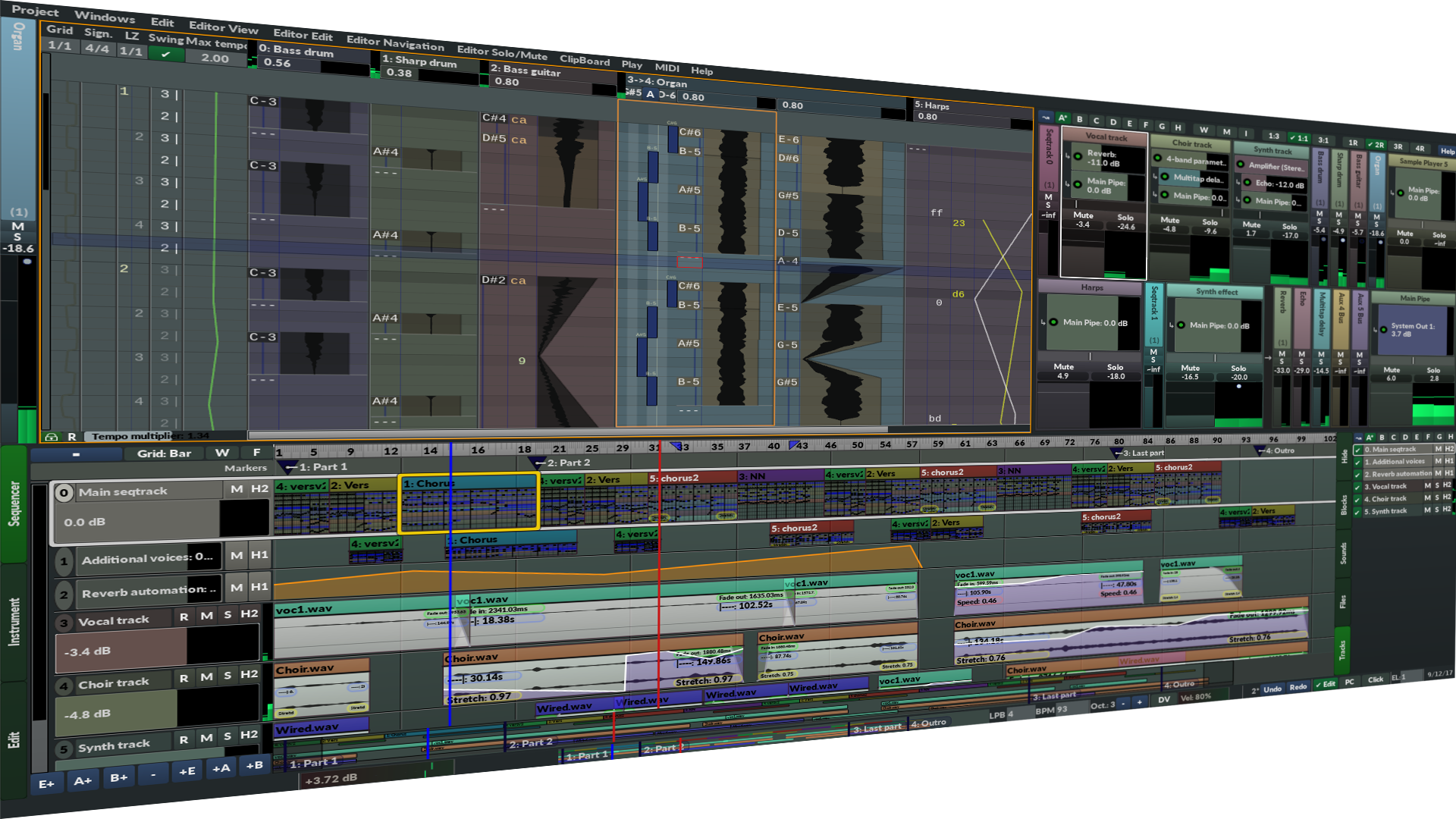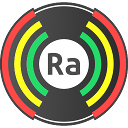About Radium
Radium is a music editor with a new type of interface.
- Compared to the piano roll interface, editing is quicker and more musical data fits on the screen. (Radium has a piano roll as well.)
- Compared to the tracker interface, note positions and effects can be edited graphically. Graphical editing provides more vertical space and gives a better visualization of musical data. (Everything can also be edited by text, like in a normal tracker, combining the best of two worlds.)
- Radium is also a Digitial Audio Workstation (DAWg), which can be used to record, edit, and mix audio.
However, despite its unusual appearance, it's a design goal for Radium to be straightforward to use, and easy to learn. It should not be harder to learn Radium than any tracker or most MIDI sequencers. Users accustomed to trackers might use more time adjusting to the interface.
History
The development of Radium started in 1999 based on ideas developed 1997-1999 while extending the Octamed tracker on the Amiga. The first public version of Radium was released in 2000. Since then, Radium has been ported to Linux, Windows, and Mac. Today, Radium is probably the worlds largest and most advanced tracker-like music editor.
Some of the features
- Audio and MIDI multitracker
- Automate pitch, velocity, effects, and tempo.
- Granular synthesis
- Smooth scrolling
- Optional piano roll
- Tickless
- Global swing, and swing-per-track
- Modular mixer and/or mixer strips
- MIDI sequencing
- Hard drive audio recording and playback
- AU, LADSPA, LV2, VST, and VST3 plugins
(More than 100 LADSPA plugins are included) - Several built-in effects and instruments
(virtual instruments, multiband compressor, modulators, etc.) - Pure Data embedded.
(Linux only for now) - Includes a Faust audio DSP development environment
- Frame-accurately synchronize playback to e.g. Ardour, Bitwig, or MASCHINE.
- Graphical zoom
- Non-destructive changable Lines Per Beat ("Line Zoom").
- Microtonality
- Scripting in Python or Scheme.
- Plugin delay compensation applied to all parts of the audio graph
- Multicore support
- Unlimited undo/redo
- Open source with a straightforward and easy to use build system (no CMake or IDEs).
Quick start
- Load a demo song from the File menu.
- Play by pressing space.
- Add a new note to the editor by pressing a key on the computer keyboard. Change octave with F1 and F2.
(Or record from MIDI input) - Look at the manual.
Contact: info@radium.dog
Follow @MusicRadium
Page was last updated: 2024-09-14
News :
- 2024-12-27: Released 7.5.71
- 2024-03-30: Released 7.4.76
- 2024-03-17: Released 7.3.84
- 2023-12-30: Released 7.2.89
- 2023-12-28: Released 7.2.87
- 2023-07-22: Released 7.1.92
- 2023-07-17: Released 7.1.90
- 2023-04-06: Released 7.1.89
- 2023-04-01: Released 7.1.88
- 2023-01-22: Released 7.1.87
- 2022-12-29: Released 7.1.86
- 2022-12-28: Released 7.0.01
- 2022-09-26: Released 7.0.00
- 2022-04-18: Released 6.9.99
- 2022-04-15: Released 6.9.98
- 2022-01-02: Released 6.9.97
- 2021-08-17: Released 6.9.96
- 2021-08-06: Released 6.9.94
- 2021-07-29: Released 6.9.90
- 2021-07-28: Released 6.9.89
- 2021-07-24: Released 6.9.88
- 2021-07-19: Released 6.9.86
- 2021-07-01: Released 6.9.82
- 2021-06-27: Released 6.9.81
- 2021-06-25: Released 6.9.80
- 2021-05-27: Released 6.9.75
- 2021-05-25: Released 6.9.74
- 2021-05-12: Released 6.9.72
- 2021-05-06: Released 6.9.71
Donate :
Is there a feature you really want? Or maybe you have an idea you want to see realized? Then support the development of Radium.
You can also help Radium get a steady progress by subscribing. Bug reports and feature requests from subscribers are prioritized. Subscribers also get access to binaries of Radium for Windows, Linux and Mac OS X.
